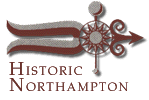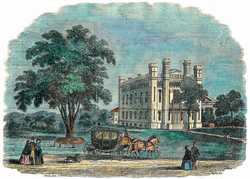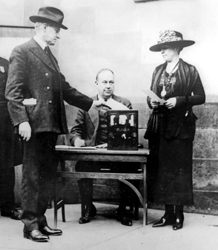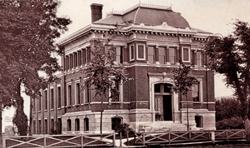
Bridge Street Cemetery Northampton Architecture Historic Markers 
|


Town Center
 |
| View of town Hall from an 1850 print |
By the mid 19th century, the simple elegance of Northampton’s buildings began to give way to the tastes and fashions of a new era of commercialism. William Fenno Pratt, who designed many of the Victorian buildings on Main Street, conceived of the Town Hall as a novelty. Completed in 1850, it combines elements of the then “new” Gothic Revival style with crenellated turrets and Norman towers replete with arrow slits. One of its most powerful detractors dubbed it a building with “flip-flops and flap-doodles.”
 |
| Calvin and Grace Coolidge, 1920 |
In 1910, a young lawyer named Calvin Coolidge became mayor of Northampton, on his way to becoming the nation’s 30th President. He is shown here voting at City Hall, with his wife Grace, in the 1920 election in which he was elected Vice-President as Warren G. Harding’s running mate.
 |
| The original Unitarian church about 1875 |
The Greek Revival Unitarian Church was built in 1825. Its classic, rational lines formalized the revolt against Calvinist doctrine and authority. Ralph Waldo Emerson was a frequent guest and speaker. When the original structure burned in 1903, it was rebuilt along the same lines in brick and granite.
 |
| Memorial Hall as it appeared in the 1870s |
Memorial Hall was built in 1871 to house Northampton’s first library and as a memorial to those soldiers who had served the town since 1654. The building was financed through public subscription and town funds. John Clarke’s bequest of $40,000 established a library that bore his name and a reading room on the first floor. The collection was absorbed by the Forbes Library when it opened in 1894.
Contents Historic Northampton.